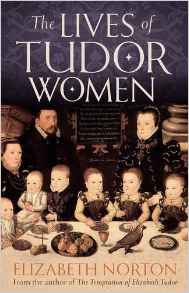 I am delighted to be the first stop on historian Elizabeth Norton’s virtual book tour for her newly released book The Lives of Tudor Women. Elizabeth joins us today with a guest article…
I am delighted to be the first stop on historian Elizabeth Norton’s virtual book tour for her newly released book The Lives of Tudor Women. Elizabeth joins us today with a guest article…
No other period in English history has been as associated with women in the popular consciousness as the Tudor age. From Elizabeth of York at the start of the dynasty, to the six wives of Henry VIII, the short-lived Lady Jane Grey, ‘Bloody’ Mary and the rival monarchs Elizabeth I and Mary, Queen of Scots. There were other women, too, less high-born and not so well remembered, but who did remarkable things. Others are not remembered at all. Yet, the lives of Tudor Women are filled interest from the lowliest to the highest, from tiny babies swaddled in their cradles to centenarians still eking out a living at their spinning wheels.
Life for a girl, as far as contemporaries were concerned, began at 90 days when a female soul was believed to enter the body. By that stage the mother had probably begun to suspect that she was pregnant. But, she could not be sure. The condition was notoriously difficult to diagnose. Could her symptoms merely be ‘her natural sickness or store of water?’ Alternatively, could her increase in girth be due to ‘some windy matter’? It was better, physicians reasoned, to wait until the baby was felt to move in the womb at around the midway point of pregnancy. Then the mother could add extra panels to her gown as required, or appear in ‘self-grow waistcoats’ and other more specific maternity wear.
There were preparations to be made for the birth, too, with most women possessing a birthing sheet and other items required for labour and beyond. For queens, the preparations could be really elaborate. But, sometimes, no preparations were made at all. Tiny Mary Cheese was born in ‘a public place’ on 1 March 1573, as her mother went about her business. The birth came so quickly and unexpectedly that the infant later died from the head injury sustained as she dropped to the floor beneath her mother’s skirts. More usually the mother gave birth on a pallet bed, attended by a midwife and female relations.
All newborns were then swaddled, before upper class infants were passed to the care of a wetnurse and other nursery attendants. A daughter could be something of a disappointment to Tudor parents, who more highly valued sons. Indeed, it affected the mother’s recovery time. She was usually permitted to be churched (i.e. ritually purified in church) more quickly after the birth of a son.
All Tudor children played with toys, with items available to suit very parental purse. For girls, there could be dolls and miniature household items, designed to teach them how to be wives and mothers in their turn. Most Tudor girls, too, received some level of schooling, thanks to the example of Sir Thomas More and his three highly educated daughters. For upper class girls, such as Henry VIII’s two daughters, this involved university-educated private tutors. Other gentle born girls might be sent to nunneries or boarded out in the house of a female tutor. Lower down the social scale, many parish churches housed small free schools, which taught both sexes reading, writing and accounting. Even the very poorest girls were expected to attend. The two younger daughters of the near-destitute Anne and Geoffrey Roberts of Norwich were recorded as still in class in 1570, although their nine-year-old elder sister had by then been pulled out of school to take up work to help support the family.
There was nothing unusual in service for Tudor girls, with all levels of society expected to leave home in their mid-teens. For gentry and noble born girls, such as Margery Wentworth, this involved joining the household of a female relative or social superior. ‘Gentle, benign and meek’ Margery was sent in the late 1480s to serve her aunt, Elizabeth Tylney, Countess of Surrey, at Sheriff Hutton Castle in Yorkshire, providing companionship and more menial service. More usually, girls would enter into a one-year contract for domestic service, living in the house of a master and carrying out domestic and farm tasks. Some girls were more formally apprenticed, although they were far outnumbered by boys. Other women would later learn a trade from their husbands. Dame Katherine Fenkyll ran her own successful draper’s business in London during the first decades of the sixteenth century, having taken over the firm on her husband’s death.
Service was not intended to be a permanent state, with girls often marrying in their twenties. While parents usually expected some input, it was considered that there should be a liking between the couple. Contemporaries reasoned that where young people were ‘beaten and compulsed’ then it was an ungodly match, with the couple marrying ‘in a forgetfulness and obliviousness of God’s commandments’. Nonetheless, for the upper classes, haggling over dowries and jointures ensured that matrimony was often approached like a business arrangement.
Childhood marriages, too, occurred, although they were vulnerable to annulment while they remained unconsummated. In January 1559 Thomas Merkingfeld, one now adult child-bridegroom, brought a suit for annulment before the Chester Church Courts. ‘He could not’, he said, ‘fantasise the said Isabella as his wife nor so would not take her and use her as his wife’. Since a valid marriage required only a promise to wed and consummation, there was no actual need of a church ceremony, although witnesses helped: the royal Catherine Grey later found her marriage disputed when one witness died and the other disappeared.
With contraceptive knowledge only rudimentary, most Tudor wives very quickly became mothers, with the lives of many women resolving around running their home, assisting their husbands in farm work or business and raising the children. Knowledge of cookery was seen as particularly important, with one contemporary reasoning that a poor cook was effectively a woman who had broken her marriage vows since ‘she may love and obey, but she cannot serve and keep him with that true duty which is ever expected’.
Women were also expected to have some medicinal knowledge, while some went so far as to take up surgery. Some were professional surgeons, such as Cecily Baldrye of Great Yarmouth who secured a licence to practice from the Bishop of Norwich in 1568. Others, such as Lady Margaret Hoby, were more amateur. Nonetheless, as Hoby recorded in her diary, she was frequently called upon to dress and treat wounds, as well as once attempting to save the life of a baby born without an anal passage. This operation was, unfortunately, futile since (as Hoby wrote), ‘although I cut deep and searched, there was none to be found’.
The vast majority of Tudor women never made it to old age, with infancy and then, later, childbirth, particularly dangerous. Old age itself must have seemed like a poor reward to many women, since there was no prospect of retirement. Old age could be particularly difficult for women, who were often viewed with suspicion. An accusation of witchcraft was a very real possibility for poorer women in the period, while even highborn ladies, such as Elizabeth I, lamented the loss of their looks. She and others of her class attempted to turn back time by plastering their faces with toxic white lead.
The Tudor dynasty, which began in the masculine heat of battle, ended in a darkened bedchamber at Richmond Palace. Elizabeth I, England’s ‘Gloriana’, died on 24 March 1603, bringing her dynasty to an end. She had come to personify her age. Those that came after her would be Stuart women.
 Book details:
Book details:
The turbulent Tudor age never fails to capture the imagination. But what was it actually like to be a woman during this period? This was a time when death in infancy or during childbirth was rife; when marriage was usually a legal contract, not a matter for love, and the education of women was minimal at best. Yet the Tudor century was also dominated by powerful and characterful women in a way that no era had been before.
Elizabeth Norton explores the seven ages of the Tudor woman, from childhood to old age, through the diverging examples of women such as Elizabeth Tudor, Henry VIII’s sister who died in infancy; Cecily Burbage, Elizabeth’s wet nurse; Mary Howard, widowed but influential at court; Elizabeth Boleyn, mother of a controversial queen; and Elizabeth Barton, a peasant girl who would be lauded as a prophetess. Their stories are interwoven with studies of topics ranging from Tudor toys to contraception to witchcraft, painting a portrait of the lives of queens and serving maids, nuns and harlots, widows and chaperones.
Elizabeth Norton is a historian of the queens of England and the Tudor period. She is the author of biographies of Anne Boleyn, Jane Seymour, Anne of Cleves and Catherine Parr, and of England’s Queens: The Biography.
Hardcover: 416 pages
Publisher: Head of Zeus (6 Oct. 2016), UK.
Language: English
ISBN-10: 1784081752
ISBN-13: 978-1784081751
The book is available as a hardcover and kindle from Amazon UK and is available for pre-order (release date: 4 July 2017) on Amazon US.